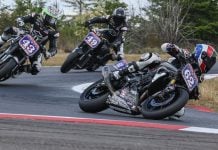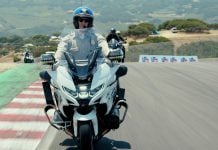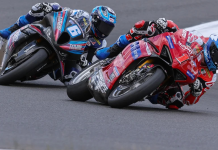Honda displayed a concept bike at Laguna Seca last weekend. A press release on the bike follows:
American Honda revealed a new concept bike at The Honda International Superbike Classic at Laguna Seca Raceway in Monterey, California.
Dubbed the New American Sports, this innovative exercise in design and styling takes direct aim at the over-arching theme that motivates the majority of motorcyclists everywhere: Gorgeous hardware.
According to Martin Manchester, project director at Honda R&D Americas, “This concept bike takes a new direction in motorcycling, a path that emphasizes the aesthetics in the execution and creation of a sport bike. Performance always takes a high profile in motorcycling, but we were looking to reinforce the emotional attachment that owners have with their bikes. We achieved that goal by placing a major emphasis on the exposed hardware on this machine, dressing it up rather than concealing it behind bodywork.
“We applied a great deal of forward-looking technology plus distinctive styling touches throughout, and lavished a huge amount of detail work on this bike. Because every bit of hardware on this machine has been designed for aesthetic appeal, the New American Sports purposely transcends the compromises typically dictated by production, function and cost issues.”

With a super abundance of eye candy (carbon fiber, titanium, machined billet aluminum) all rolled into one package, it becomes difficult to list the highlights on this forward-think exercise. Centralizing the mass around the engine played a key role in the original design, and the front and rear ends are purposely left with a light and airy appearance. A carbon fiber/aluminum mono-arm front suspension with a massive steering head and integrated steering damper certainly draws attention, as do the organically shaped billet wheels and aluminum frame. The single floating rim-mounted front brake is likewise startling in appearance, and then you notice that the handsomely finished liquid-cooled V-Twin engine appears to lack a radiator–it’s actually hidden away beneath the bodywork in the abbreviated tail section!

Exquisitely formed carbon-fiber skinwork abounds, and the single-sided Pro-Arm swingarm incorporates a skeletonized structure. Four projector beam headlights lend to a compact nose, and the Indiglow instruments along with the compact controls and switches add to the clean, Spartan look.
As Martin Manchester summarizes, “We set out to re-create the sports category using the inherent beauty of well-executed motorcycle hardware. This concept should attract the serious enthusiasts, those who appreciate the high-tech, finely turned-out elements in a motorcycle.”
Take one look at the New American Sports, and you’ll surely agree. But then, what else would you expect from an all-out effort by Honda R&D Americas?















